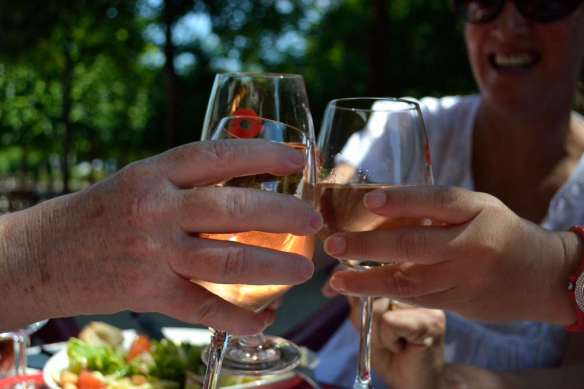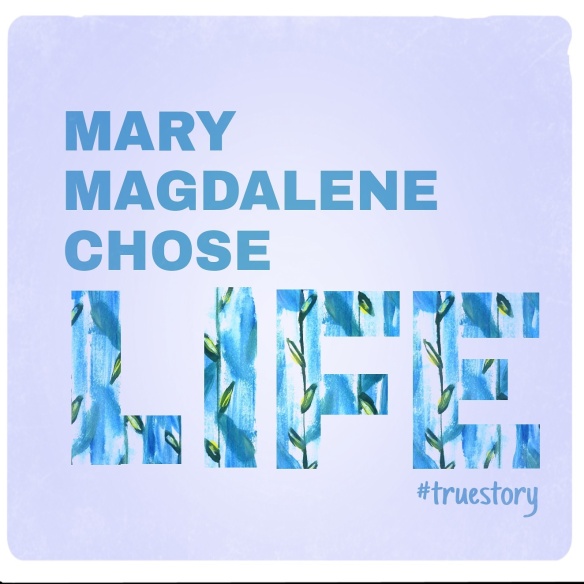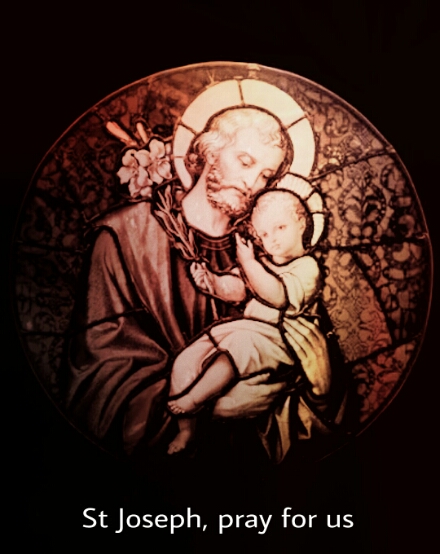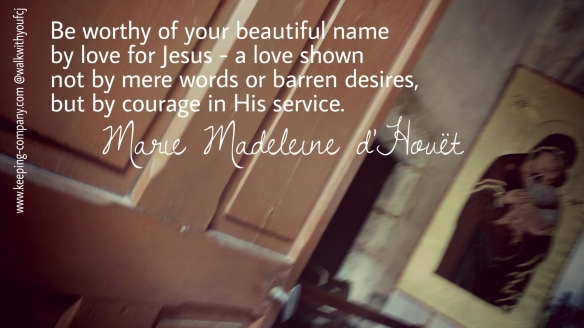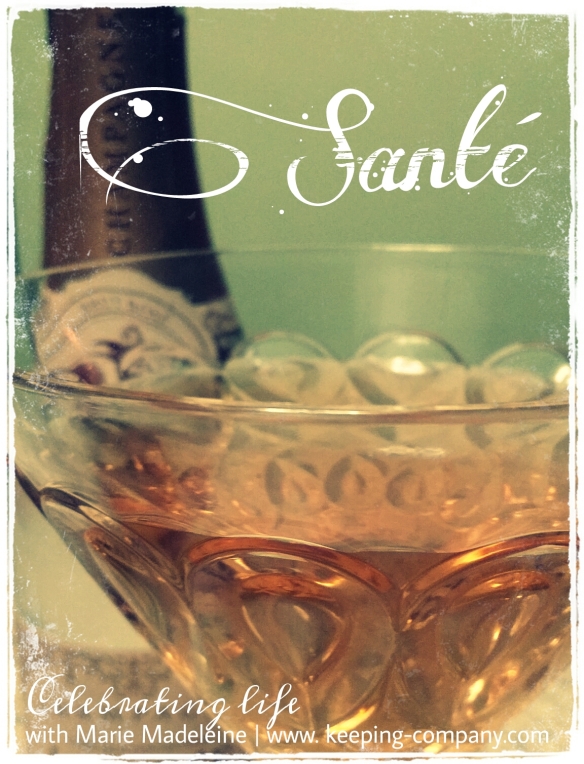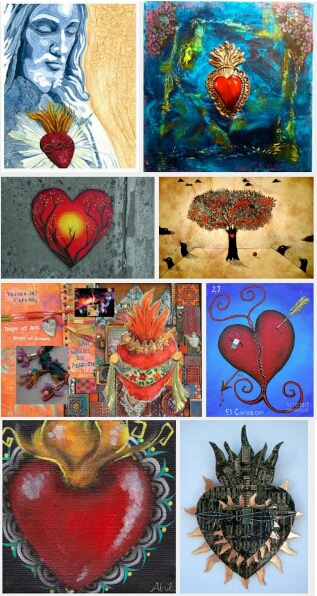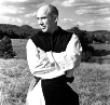The following reflection is a guest post submitted by one of the pilgrims who “walked with us” on the pilgrimage I made earlier this year.

Image: G. Anderson, 2014.
In the footsteps of Marie Madeleine
Some time on, and I am still in awe of the fact that one woman, who lived 156 years ago is the reason that in 2014, 32 pilgrims, 5 FCJ sisters and one coach driver are gathered in Central France, visiting countless churches, houses, run down country estates, disused chapels, negotiating winding country roads, unsure of which turn to take, in order to find four generations of a family willing to welcome a group of strangers, who don’t speak their language, into their home and treat them like long lost friends.

The generous spread provided by the de Bonnault-de Bengy families.
Image courtesy: A. Daw, 2014.
It is a fact that we are reminded of as we sit, (at the feet of the master, who is Sr. Mary Campion) in the garden of Rue Coursalon in Bourges, on a very sunny and hot afternoon in July. The group, representing four continents, is grappling with the question, “Am I a tourist or a pilgrim?” “What is the difference?” Someone in the group suggests that the pilgrim is someone who is searching for the meaning of things and I am reminded of the quote from The Little Prince,
It is only with the heart that one can see rightly; what is essential remains invisible to the eye. | Antoine de Saint-Exupery
And so, our focus goes beyond the facts of the story which is unfolding before us… We begin to glimpse the young woman, mother and daughter who is struggling to do the right thing, against a backdrop of political unrest, social upheaval and is torn between her strong sense of family duty and her desire to seek only the will of God and accomplish it faithfully, as soon as it is made known to her. It is a struggle, not unlike the struggles of this group of pilgrims, nearly 200 years later. Conversations deepen and centre on questions of justice and dignity for individuals and groups in our 21st-Century world. We come to the conclusion that if Marie Madeleine were here today, it would be these same issues that she would want to tackle.
Our own journey has had its own (albeit trivial) problems, including some geographically challenged sheets and pillows while in Amiens, which means rising with the sun to ensure they can be safely returned or packed away, to travel south with us toward Paris.
There is also the wing mirror on the apparently new coach, which refuses to open and means a three hour wait for a mechanic in Bourges. What to do? Make sure that everyone is as comfortable as possible, with something to eat and drink – perhaps find somewhere to sit in the shade, try to fix the problem ourselves, or find a seat at the back of the bus and start praying – and we mustn’t forget our time of sharing, so some of us sit in the park to reflect on what has happened today…

Liverpool and Benalla men in impassioned discourse. Image courtesy I. Demase, 2014.

The coach driver with our other ‘driver’, Sr Lorenza in the driver’s seat. Image courtesy: I. Demase, 2014.

The mechanic arrives! Image courtesy: I. Demase, 2014.

Pilgrim-companions behind the Cathedral in Bourges. Luckily there was a pub nearby. Image: G. Anderson, 2014.
But NO-ONE complains… Good example does much good. We have witnessed the sisters living out community in its truest sense. We have seen ‘the love and care they have for one another’ and what they have done and continue to do for us. Then, for me, another realisation – we are no longer strangers or friends – we are all companions and Marie Madeleine’s spirit is very much alive and living amongst us! Conversations go deeper again, and there is a dawning realisation that whatever work we ‘do’, if it is done for the ‘good of the other’, then it is God’s work and work that Marie Madeleine would have happily undertaken.
The ‘end’ of our journey lies in Paris, almost where we began, as we arrive at the parish church of St Dominique. Having travelled the labyrinth of roads around France and our lives, we finally arrive on the holiest of ground, to be welcomed with open arms by the church community, who are curious to know where we have come from and who might, like us, be in awe of the fact that one woman, who lived 156 years ago has brought this group of companions together to pray in their church.
And then we are gone…. As quickly as we came, back to our realities and daily lives, but richer for the experience. The ‘end’ of our journey is but the beginning and we are no longer alone in our daily struggle.
We are a community which transcends time and space. We are strengthened in our resolve to continue our work with the prayerful support of each other. The prayer, this week, has been powerful. We marvel at how, at each place, the prayer is ‘spot on’, speaks to us, moves us.
For me, it is yet more evidence of the beauty of God’s creation. We have worked together on it, across vast distances, with people we may not yet have known. It has helped shape our experience together and has allowed us to be a community of pilgrims rather than a group of tourists.
Through the skillful and dedicated work of our FCJ guides, Marie Madeleine has been given life and we have all returned home with a new understanding of who she is, the sacrifices she made, and the very real struggles she had in trying to do what she believed God wanted of her.
We give thanks for this very special opportunity and for the many blessings and graces received during our privileged time together.
This reflection was graciously offered by a fellow pilgrim-companion.
*Do you have your own reflection or pilgrimage story to share? For contributions, and to discuss possible authorship, please contact Geralyn via email: missionandidentity@fcjasau.org.au.
